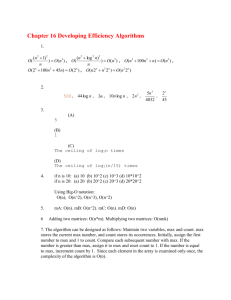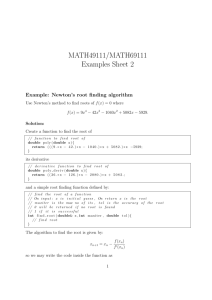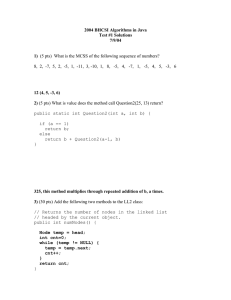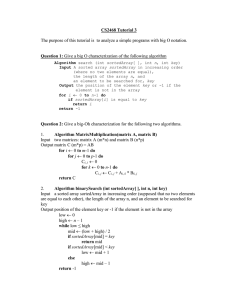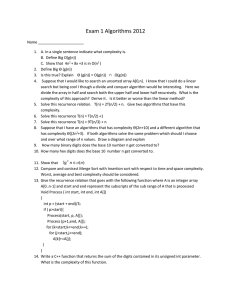Chapter 24 Developing Efficient Algorithms
advertisement
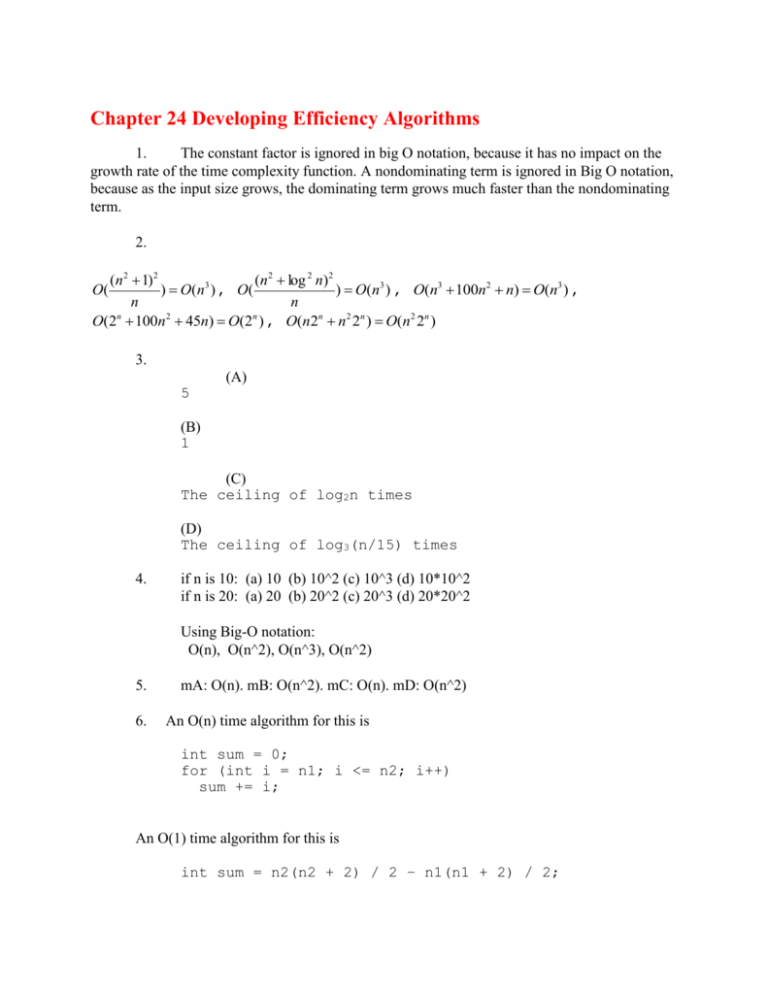
Chapter 24 Developing Efficiency Algorithms
1.
The constant factor is ignored in big O notation, because it has no impact on the
growth rate of the time complexity function. A nondominating term is ignored in Big O notation,
because as the input size grows, the dominating term grows much faster than the nondominating
term.
2.
(n 2 1) 2
(n 2 log 2 n)2
) O( n3 ) , O(
) O(n3 ) , O(n3 100n2 n) O(n3 ) ,
n
n
O(2n 100n2 45n) O(2n ) , O(n2n n2 2n ) O(n2 2n )
O(
3.
5
(A)
(B)
1
(C)
The ceiling of log2n times
(D)
The ceiling of log3(n/15) times
4.
if n is 10: (a) 10 (b) 10^2 (c) 10^3 (d) 10*10^2
if n is 20: (a) 20 (b) 20^2 (c) 20^3 (d) 20*20^2
Using Big-O notation:
O(n), O(n^2), O(n^3), O(n^2)
5.
6.
mA: O(n). mB: O(n^2). mC: O(n). mD: O(n^2)
An O(n) time algorithm for this is
int sum = 0;
for (int i = n1; i <= n2; i++)
sum += i;
An O(1) time algorithm for this is
int sum = n2(n2 + 2) / 2 – n1(n1 + 2) / 2;
7.
result = a;
i = 2;
while (i <= n) {
result = result * result;
i *= 2;
}
for (int j = i / 2 + 1; j <= n; j++)
result = result * a;
Assume that 2 k 1 n 2 k . The while loop is executed k-1 times. The for loop is
executed at most 2k 2k 1 2k 1 times. So, the total complexity is O(n).
Consider another implementation:
public static int f(int a, int n) {
if (n == 1) {
return a;
}
else {
int temp = f(a, n / 2);
if (n % 2 == 0) {
return temp * temp;
}
else {
return a * temp * temp;
}
}
}
This implementation results in O(logn) complexity.
8.
500, 44 log n , 3n , 10n log n , 2n 2 ,
9.
5n 3
2n
,
4032
45
Adding two matrices: O(n*m). Multiplying two matrices: O(nmk)
10. The algorithm can be designed as follows: Maintain two variables, max and count.
max stores the current max number, and count stores its occurrences. Initially, assign the
first number to max and 1 to count. Compare each subsequent number with max. If the
number is greater than max, assign it to max and reset count to 1. If the number is equal
to max, increment count by 1. Since each element in the array is examined only once, the
complexity of the algorithm is O(n).
11. The algorithm can be designed as follows: For each element in the
input array, store it to a new array if it is new. If the
number is already in the array, ignore it. The time for
checking whether an element is already in the new array
is O(n), so the complexity of the algorithm is O(n^2).
12. This is similar to bubble sort. Whenever a swap is made, it goes back to the beginning
of the loop. In the worst case, there will be O(n^2) of swaps. For each swap, O(n)
number of comparisons may be made in the worst case. So, the total is O(n^3) in the
worst case.
13. See the definition and example in the text.
14. The recursive Fibonacci algorithm is inefficient, because the subproblems in the
recursive Fibonacci algorithm overlaps, which causes redundant work. The nonrecursive Fibonacci algorithm is dynamic algorithm that avoids redundant work.
15. To prove this is wrong, all you need is to give a counter example to show the
algorithm does not work. Try n = 64 and m = 48. The algorithm will produce the gcd
8, but the actual gcd is 16.
16. If n is not a prime, then there exists two number n1 and n2 such that n1 * n2 = n.
Assume n1 <= n2, n1 <= n . If n1 is not a prime, you can continue the same process to find the
factors of n1, until a factor is a prime.
17. See the text.
18. See the definition and example in the text.
19. See the text.
20. Yes. Finding the minimum in the first half and the second half of the list and return
the minimum of these two. So, the time complexity is O(n) = 2 * O(n/2) + O(1) =
O(n).
21. See the definition and example in the text.
22. O(n!)
23. See the text
24. See the text
25. See the text
